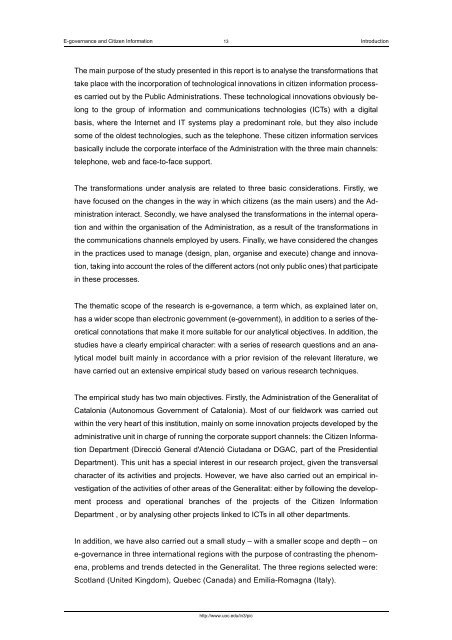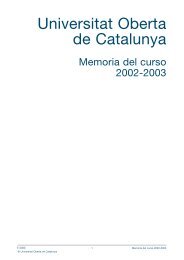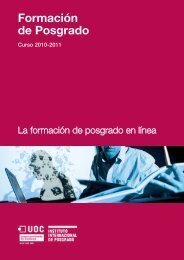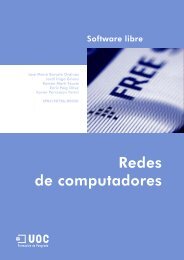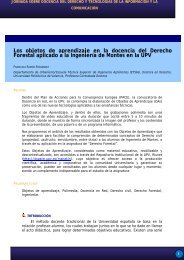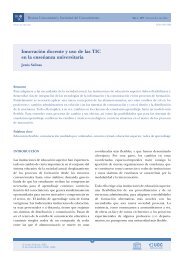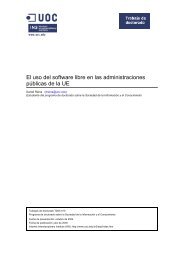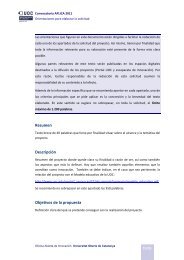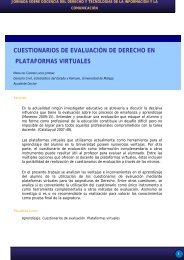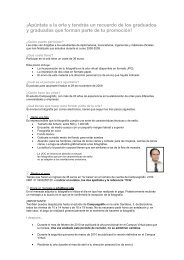e-governance and citizen information - Universitat Oberta de ...
e-governance and citizen information - Universitat Oberta de ...
e-governance and citizen information - Universitat Oberta de ...
Create successful ePaper yourself
Turn your PDF publications into a flip-book with our unique Google optimized e-Paper software.
E-<strong>governance</strong> <strong>and</strong> Citizen Information 13 IntroductionThe main purpose of the study presented in this report is to analyse the transformations thattake place with the incorporation of technological innovations in <strong>citizen</strong> <strong>information</strong> processescarried out by the Public Administrations. These technological innovations obviously belongto the group of <strong>information</strong> <strong>and</strong> communications technologies (ICTs) with a digitalbasis, where the Internet <strong>and</strong> IT systems play a predominant role, but they also inclu<strong>de</strong>some of the ol<strong>de</strong>st technologies, such as the telephone. These <strong>citizen</strong> <strong>information</strong> servicesbasically inclu<strong>de</strong> the corporate interface of the Administration with the three main channels:telephone, web <strong>and</strong> face-to-face support.The transformations un<strong>de</strong>r analysis are related to three basic consi<strong>de</strong>rations. Firstly, wehave focused on the changes in the way in which <strong>citizen</strong>s (as the main users) <strong>and</strong> the Administrationinteract. Secondly, we have analysed the transformations in the internal operation<strong>and</strong> within the organisation of the Administration, as a result of the transformations inthe communications channels employed by users. Finally, we have consi<strong>de</strong>red the changesin the practices used to manage (<strong>de</strong>sign, plan, organise <strong>and</strong> execute) change <strong>and</strong> innovation,taking into account the roles of the different actors (not only public ones) that participatein these processes.The thematic scope of the research is e-<strong>governance</strong>, a term which, as explained later on,has a wi<strong>de</strong>r scope than electronic government (e-government), in addition to a series of theoreticalconnotations that make it more suitable for our analytical objectives. In addition, thestudies have a clearly empirical character: with a series of research questions <strong>and</strong> an analyticalmo<strong>de</strong>l built mainly in accordance with a prior revision of the relevant literature, wehave carried out an extensive empirical study based on various research techniques.The empirical study has two main objectives. Firstly, the Administration of the Generalitat ofCatalonia (Autonomous Government of Catalonia). Most of our fieldwork was carried outwithin the very heart of this institution, mainly on some innovation projects <strong>de</strong>veloped by theadministrative unit in charge of running the corporate support channels: the Citizen InformationDepartment (Direcció General d'Atenció Ciutadana or DGAC, part of the Presi<strong>de</strong>ntialDepartment). This unit has a special interest in our research project, given the transversalcharacter of its activities <strong>and</strong> projects. However, we have also carried out an empirical investigationof the activities of other areas of the Generalitat: either by following the <strong>de</strong>velopmentprocess <strong>and</strong> operational branches of the projects of the Citizen InformationDepartment , or by analysing other projects linked to ICTs in all other <strong>de</strong>partments.In addition, we have also carried out a small study – with a smaller scope <strong>and</strong> <strong>de</strong>pth – one-<strong>governance</strong> in three international regions with the purpose of contrasting the phenomena,problems <strong>and</strong> trends <strong>de</strong>tected in the Generalitat. The three regions selected were:Scotl<strong>and</strong> (United Kingdom), Quebec (Canada) <strong>and</strong> Emilia-Romagna (Italy).http://www.uoc.edu/in3/pic


